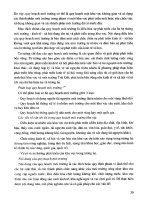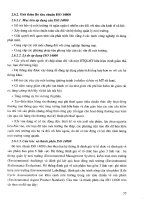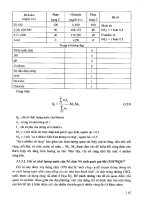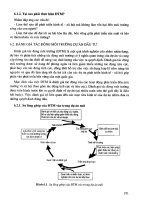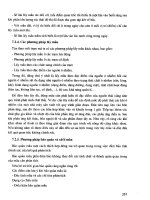Bài giảng quản lý chất lượng môi trường trong nuôi trồng thủy sản phần 2
Bạn đang xem bản rút gọn của tài liệu. Xem và tải ngay bản đầy đủ của tài liệu tại đây (5.91 MB, 152 trang )
QUẢN LÝ CHẤT LƯỢNG MÔI TRƯỜNG
TRONG NUÔI TRỒNG THỦY SẢN
Chương 3:
Khái niệm về vi sinh vật trong nguồn nước
Microbial Interactions with Macroorganisms
Aquatic environment is relatively
rich in microorganisms
Up to 105 to 106 cells / mL
Cilliates, other protists, and viruses
Macroorganisms in aquatic
environment
Constantly exposed to
microorganisms
Historical perspectives
Changes during storage
Effects on spoilage
Relationship between
environmental and fish
microflora
Basis for monitoring changes in fish
farms
Disease causing bacteria
Human
Fish & Shellfish
Increasingly, more focus on normal
microflora and their interactions
with the host organisms
Microbiology of bivalve mollusks
Microorganisms as food
Natural microflora
Filter feeders and the ecosystem
Hansen and Olafsen, 1999; Maeda, 2002
Microorganisms as food
Filter feeders
(Suspension feeders)
Feed on microorganisms that
they filter out of the
environment
Clams, oysters, barnacles,
sponge
Deposit feeders
Feed on microorganisms that
coats the surface of sediments
and soil particles
Worms, fiddler crab
Larval forms of animals may require smaller microorganisms
such as bacteria, while an adult may prefer larger
microorganisms such as flagellated protists and algae
Oyster anatomy
Labial palps
Visceral mass
Lower intestines
Draw water in over its gills
through the beating of cilia
Suspended food (plankton) and
particles are trapped in the
mucus of the gills
Sort by labial palps and transport
to the mouth, eaten, digested,
and feces expelled
Pseudofeces = particles which are
not sorted as food and are
rejected through the mouth
Affect by temperature
Rectum and anus
Greatest when water temperature
> 50°F (~10°C)
Oyster anatomy lab- />
Oyster filtering mechanism lab- />
Natural microflora of mussels and oysters
A majority of isolates are gram-negative (68%) and aerobic
(76%) bacteria
Predominant flora: Vibrio, Pseudomonas, Shewanella,
Aeromonas, Acinetobacter, and Flavobacterium
Gram-positive bacteria: Staphylococcus, Bacillus,
Streptococcus
Predominant Vibrio species includes:
V. alginolyticus, V. splendidus, and V. (Listonella) anguillarum*
Not always reflect external environment
Suggests selective process to sequester and maintain certain species
Kueh and Chan, 1985 ;Hariharan et al., 1995
Filter feeders and the ecosystems
An adult oyster can filter as much as 60 gallon per day
Oysters can filter out sediments and nutrients (nitrogen) and
deposit them on the bottom
“Top-down" grazer control on phytoplankton
Reduce turbidity, increasing the amount of light reaching the sediment
surface
Extending the depth to which ecologically important benthic plants
(seagrasses and benthic microalgae) can grow
Newell, 2004 ;Chesapeake Bay Foundation- />
Filter feeders bivalves removing inorganic and organic particles from water column and
transferring undigested particulate material to the sediment in the form of their biodeposits
Newell, 2004
Microbiology of Fish
Eggs, skin, gills microflora
Intestinal microflora
Bacteria on mucosal surface (1)
Host-parasite relationship
Host = an organism which harbors parasite (microorganisms)
Parasite = an organism that lives on or in a second organism
Surfaces such as eggs, skin, gills, and intestinal tract
Mucus layer as an adhesion site and protective layer
Indigenous vs. transient (autochthonous vs. allochthonous)
Indigenous = able to grow and multiply on the surface of the host animal
Transient = not able to grow or multiply on the surface of the host animal;
does not persist for a long period of time
Bacteria on mucosal surface (2)
Loose association
Adhesion
Invasion
Eggs microflora
Fish embryos secret inorganic and low molecular weight organic
compound, which can diffuse out through the shells
Attract bacteria utilizing these compounds and colonize egg
surface
Normal healthy eggs flora: Cytophaga, Pseudomonas
Dead eggs: fluorescent Pseudomonas
Not the cause of dead, but rather attracting to nutrient leaching
Overgrown of bacteria can hamper eggs development
Leucothrix mucor on cod eggs
Flavobacterium ovolyticus on halibut eggs
Cahill, 1990; Hansen and Olafsen, 1999
Skin Microflora
Reflect that of surrounding water
May have from 102 to 104 bacteria/ cm2
Unit of measurement per area
Surface sampled by using a sterile swab
Muscle tissue should be sterile
Gram negative: Pseudomonas, Moraxella, Vibrio, Flavobacterium,
Acinetobacter, Aeromonas
Gram positive: Micrococcus, Bacillus
Cahill, 1990
Gill Microflora
May contain 102 to 106 bacteria/ g
The number is quite low considering its high surface area and being
continual flushed by water
Extensive colonization of certain types of bacteria (Flavobacterium)
Gram negative: Pseudomonas, Flavobacterium, Vibrio,
Moraxella, Cytophaga
Gram positive: Micrococcus, Bacillus (in warmer water)
Cahill, 1990
Intestinal microflora (1)
Established at the larval stage
Developed into a persistent flora at the juvenile stage
Population of microorganisms tends to increase along the length
of the GI tract
Largest number of bacteria in the intestines (up to 108 CFU/g)
Gram negative: Pseudomonas, Vibrio, Achromobacter,
Flavobacterium, Corynebacterium, Aeromonas
Gram positive: Bacillus, Micrococcus
Influenced by stages of life, diets, feeding, water temperature,
habitat
Large number when feeding, very few when not feeding
Organic content of the environment
Vibrio dominates in seawater, Aeromonas dominates in freshwater
Cahill, 1990; Hansen and Olafsen, 1999
Intestinal microflora (2)
Microvilli of the epithelial cells of
common wolffish (A. lupus L.)
Bacteria
SEM of the enterocytes in the
midgut of Artic charr
Ringo et al., 2003
Intestinal microflora (3)
Endocytosis of bacteria in the
hindgut of spotted wolffish fry
Bacteria
TEM of Atlantic salmon gut epithelium
Ringo et al., 2003
Aquaculture of marine larval fish
Yolk-sac
First feeding
Larvae
Juvenile
More difficult to raise compared to
freshwater
Smaller egg size
Smaller size at hatching
Longer larval duration
Higher mortality rates
Mass mortality often with unknown
cause
Nutrition?
Disease?
Little is known about the role of
intestinal microorganisms
Adult
Fuiman, 2002
Fish Anatomy
Larva
Adult
Development of the intestinal
microbiology
At the time of hatching, the digestive tract of most fish species is an
undifferentiated straight tube
Prior to first feeding, microbiology reflects that of the rearing
environment
Marine larvae needs to “drink” to osmoregulate
Influence by eggs, live feed, and rearing water
Once feeding begins, microbiology is derived from live feed
ingested rather than water
As the digestive tract becomes more developed, the intestinal
microbiology becomes more stable and more complex
pH change (lower)
O2 tension (more anaerobic)
Receptors for bacteria
Ringo and Birkbeck, 1999; Birkbeck and Verner-Jeffreys, 2002
Development of the intestinal microflora
(2)
Criteria for testing whether or not microorganism is indigenous to
the intestinal tract of fish:
•
•
•
•
•
Found in healthy individuals
Colonize early stages and persist throughout life
Are found in both free-living and hatchery-cultured fish
Can grow anaerobically
Are found associated with the epithelial mucosal in the stomach, small
intestine or large intestine
Ringo and Birkbeck, 1999
Roles of intestinal microflora
Nutrition
Polyunsaturated fatty acids, amino
acids and vitamins
Extracellular enzymes: chitinase
Preventing infection from fish
pathogens
Competitive attachment
Neutralization of toxins
Bacteriocidal activity
Survival and growth
Bacterial load impact on survival &
digestive organ development
Presence of certain species influence
survival
Stimulation of the immune system
Provide antigens to trigger development
of immune responses in the gut
Pre-release China rockfish
Ringo and Birkbeck, 1999; Photo by Mark Tagal





